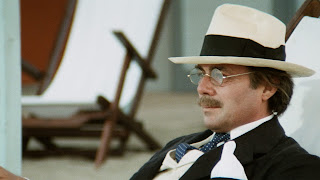Death in Venice (Luchino Visconti, 1971, Italy/France)
Death in Venice, the second film in Luchino Visconti's "German Trilogy", is a visually stunning examination of decadence. The film was one of Visconti's many literary adaptations, this time of Thomas Mann's seminal 1912 novella. The adaptation is generally faithful to Mann's largely interior work, with a few significant changes. Most notably, the main character Gustav von Aschenbach is changed from a poet to a composer. Visconti no doubt identified autobiographical elements in Mann's novella, and the "public" nature of a composer's job felt similar to that of a filmmaker. This change also lends the film its recurring and uniquely identifiable musical motif - the Adagietto from Gustav Mahler's Fifth Symphony. Rarely has a piece of classical music been used so evocatively within a film.
Legendary British actor Dirk Bogarde is excellent as von Aschenbach, conveying a general sense of irritability, and an acknowledgment of his demise. Worthy of his documentary (he has recently received one), Swedish actor Bjorn Andresen has become iconic in his own right as the mysterious Polish boy - Tadzio. Mann's original novella is deeply philosophical and psychological, largely oriented around Nietzsche's conception of the Apollonian versus Dionysian drives. Some complain that Visconti over-literalizes Mann's novel, and it is true that much of the subtlety of Mann's novella is lost. That being said, Visconti has a different style than Mann - one which is all his own. The set designs, the costumes, and every little detail (Visconti was notorious when it came to details, even filling the cabinets with accurate items) express the feeling of the decadence of fin de siecle Venice. In our own time of disease, there is something even more moving about the film's finale. The film's final shot in the sunset is truly one of the most iconic cinema has ever produced, and worthy of preservation.
10/10




Comments
Post a Comment